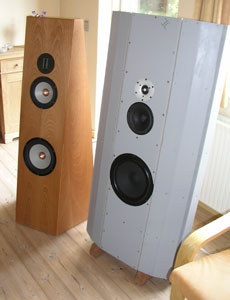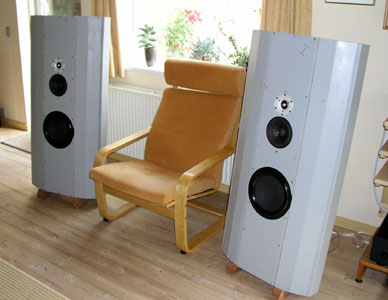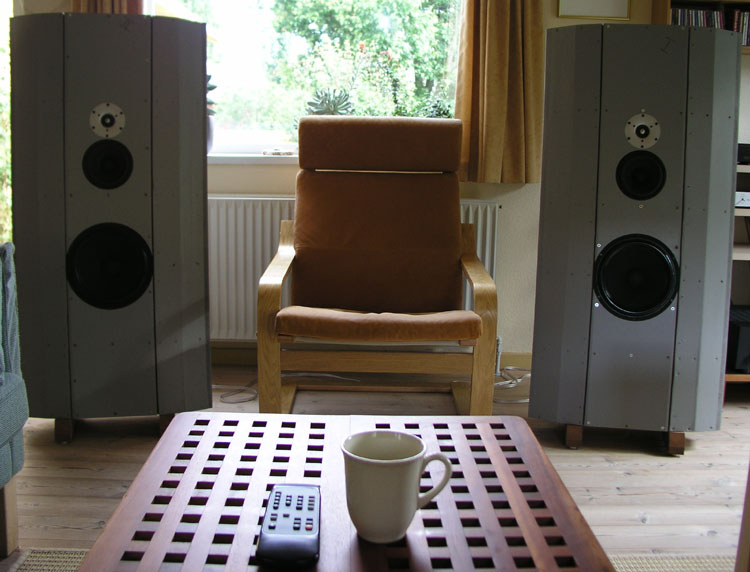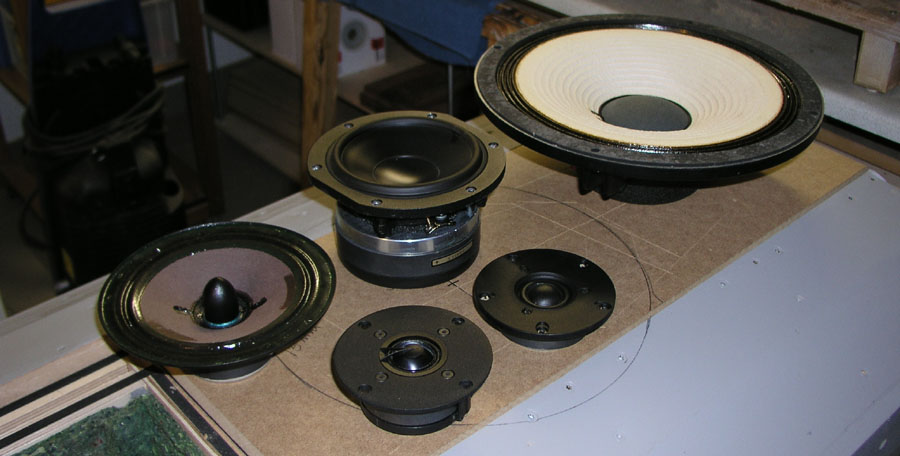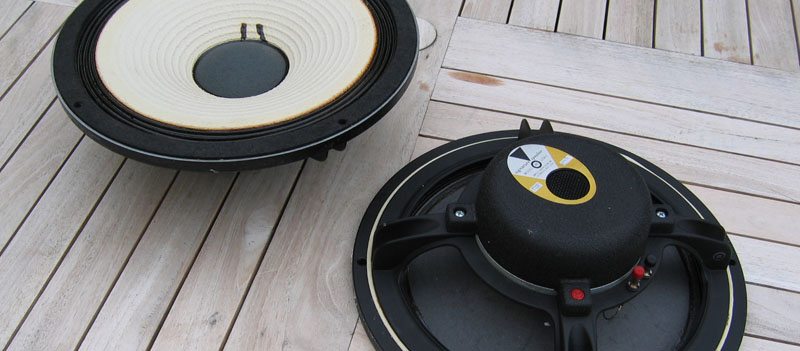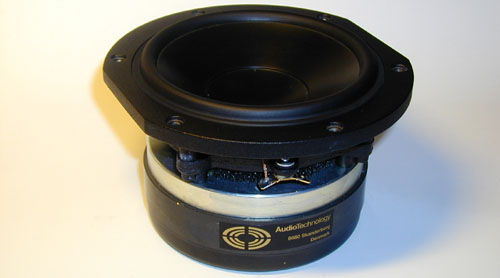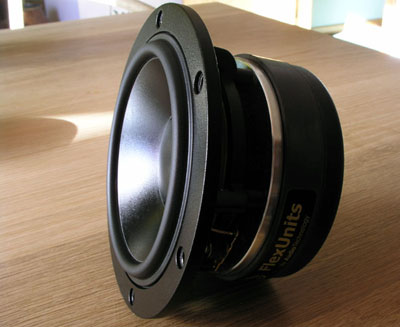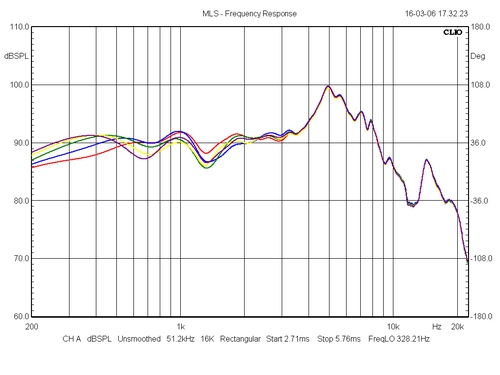|
DIY Loudspeakers: HOME INDEX UPDATES RESPONSE WHAT'S NEW
Wide baffle speakers
Working on dipoles - or semi-dipoles - was a new entry to my hobby and it took my plans into a new direction. Having lived with my semi-dipoles for more than a year, I have a hard time adjusting to any "boxy" sound again. The midrange sounds constrained with limited soundstage and articulation. The obvious next step would be the dipole bass, but I've had my share of electronic crossovers and multiple amps in the past and for the time being I want to keep things fairly simple: One amp and a pair of speakers with passive crossovers. That's all. The launch of the Stradivari by Sonus Faber has created quite a debate and what has been argued against wide baffled speakers is some loss of pinpoint imaging. Here are some different views on the subject.
Mr. José
Victor
Henriques
from his review of the new Sonus Faber Stradivari speaker: "Live pin-point focus": Has high-end HI-FI forgotten something here? The trend in recent years has been towards speakers with very narrow front baffles, trying to eliminate reflecting surfaces around the drivers, presumably enhancing pinpoint imaging. And with apparent commercial success. What is the trade-off? Because there's always a trade-off in speaker building. Well, by having a very narrow front baffle we will have edge diffraction at a rather high frequency giving delayed response subtracting from the target of pin-point imaging. We all know that a round sphere is the ideal surrounding for a speaker but for large speakers the sphere has to be large, very large and the WAF is close to zero. We never saw a commercial success from a sphere shaped speaker where the very narrow and slim line speakers can be rather deep (to give volume) and still appear smallish = high WAF.
Paul
Messenger:
Henriques
again:
With a 66 cm wide baffle the Stradivari mid-drivers hardly need any baffle step compensation. It will be flat down to 200-300 Hz.
Roy Allison
(former Acoustic Research and Allison Loudspeakers) in
Stereophile, Jan/05) on the development of the Allison Model-1:
Calling a
50-60 cm wide baffle an infinite baffle is a truth with some
modifications. Having an infinite baffle would mean mounting the
drivers on the wall, creating a true 2pi environment. By making a wide
and curved baffle cabinet, edge diffraction is avoided and a virtual
2pi radiation pattern is produced. Any driver mounted on a baffle will
have an f3 = 11,600/width of baffle in cm. A driver mounted on a baffle
of 20 cm with will be down 3 dB at 11,600/20 = 580 Hz. Making the
baffle 50 cm wide the f3 is reduced to 232 Hz. Enough for a midrange
driver working from 300-400 Hz to release its full potential without
baffle step compensation. To read more about baffle step compensation
and cabinet edge diffraction, try the following links: Ken Kessler writes in his report on the Stradivari that it sounds like a dipole, so whether the midrange here will have to work as a true dipole is to be seen. Prototype baffles will have to be flexible to accommodate both vented midrange boxes and dipole arrangements. The sketches shown here are purely made to start thinking in curved, wide baffled constructions. No dimensions or calculations at this stage. A truly curved front panel is not an easy task and will probably require gluing several layers of thin MDF or plywood sheets over curved internal bracing. Download Acapella WB file from here
Acapella WB
Getting the Acapella WB test cabinets into the living room from the workshop (at the basement) was quite a problem and a sack barrow was needed! These cabs are heavy! And before I go on with this story I also have to tell that the current cabinet size and colour has a close to zero WAF. So, you are warned. Patricia Barber from her "Paris Live" recording was first on the CD player and I think it's the first time I've heard the French introduction with the acoustic scale the male voice requires and the first time I got a real sense of the size of the room where the concert takes place. These speakers have a phenomenal ability to reveal room ambience. Should you worry about wide baffles having reduced transparency and pinpoint imaging, then you can happily forget about it. You can never really know how a person perceives the acoustic properties of a loudspeaker no matter how many explanations, but I do think I have an idea of what Ken Kessler means when he writes that the Stradivari sounds like a dipole without being a dipole. This is exactly what they do. I have been wondering what he meant by this and thought it was some smart phrasing, but it isn't. The wide curved baffle has a benign way of projecting the sound waves into the room and I'm beginning to think that if you have to choose between reflection and diffraction, then reflection is the way to go. From a wide baffle you really don't have a delayed response of signals - at least not in the frequency domain that counts, upper mid and treble. And the baffle step really doesn't occur until the sound waves have lengths where they are omni-directional anyway.
As always, excitement is high the first time you
connect a new pair of speakers. Will they deliver from all the working
hours put into them - and these are just test cabs! If they are good
I'll have to do it all over.....
The very simple series crossover shown in the pdf file
was constructed for the MT and a ruler flat response was measured from
300 to 22000 Hz - the upper limit of the CLIO system.
My expectations to sensitivity were very high (Tannoys
still fresh in memory) and I was initially a little disappointed from
this until I realised how high I was playing. This speaker can play
loud without apparent distortion and it takes an act of will to turn
the volume knob down to normal listening level because the level of
transparency is so good that you have to hear all the details on every
piece of music. These speakers handle female vocals very well. They may not be completely neutral, but they can be played loud = lack of distortion. And going from solid state amplification (electronic crossover + 2 solid-state amps) to the Copland CTA 505 improved this somewhat. Sometimes paper cones and valves go hand in hand and this appear to be the case for the Acapella WB. I'm hesitant to coat the middriver. I know it will take some edginess, but also some vividness and well, colouration if you like. It's remarkable that paper cones have survived until this very day despite numerous alternatives with much better physical properties. But well produced paper cones have a "thing" that any other cone material hasn't.
In my small workshop the bass initially seemed a
little low in level and extension, but it is not often you can hear
anything from a 31 Hz warble tone, but this one can tell you it's
there. And getting the speakers into the much larger living room
certainly opened the bass and there was the level and extension. The
transient attach of the bass could be better (kick drum) and I have to
experiment with a smaller cabinet size and possibly a higher vent
tuning before I look for other drivers.
15-08-2005 Update Acapella WB
Seen above is a range of drivers suggesting quite some confusion. The 15M4531 ScanSpeak mid driver is gone; the 7000 tweeter is gone and in comes an AudioTechnology driver and a crummy looking old SEAS paper cone driver from the early Eighties. And a 12" JBL bass driver! There's always a honeymoon with speakers. You may instantly recognise strengths and weaknesses from a new set-up, but it can take days, sometimes weeks to find out whether you can live with the sound from a driver and the way this particular driver will colour the sound, because all drivers do. The 10" paper cone bass drivers did great and the 7000 tweeter also, but the 15M4531K00 driver will drive you nuts in the long run. Scan-Speak has done a fine job in elimination major break-up patterns usually associated wit paper cones but this does not mean this driver doesn't have some residual "paper" (honky) quality to its sound. This driver is phenomenal in accentuating sh... sounds and every sibilant recording will shred you ears. After some time the 15M driver was coated with a coating material obtained from Speakerbits in Australia: http://www.speakerbits.com/Default.aspx. Actually the glue used for refoaming drivers. This material is well suited for coating paper cones and leaves a nice, non-sticky, flexible surface if done properly. This treatment did not change the frequency response and it improved the sound considerably. For some days I thought this was the cure, but something just kept these drivers from having a neutral presentation. One very noticeable thing is when a high piano note is played and the 15M will smack in your face, but the note doesn't stop fast enough. It's like the 15M is ringing. Does the combination of a high mechanical Q, the kapton voice coil and the paper cone produce this effect? Is a middriver with better damping what's needed?
Tweeter attenuation was tested thoroughly and a new
parallel crossover for the MT was constructed but this didn't perform
better than the former series crossover. Out of frustration I inserted
some old SEAS paper cone drivers (actually from a B&O speaker, S25) and
well, these drivers do not have the level of transparency compared to
the 15Ms, but vocals just started sounding right, actually very good.
Hmm... Seriously, a 25 year old el-cheapo driver! Next I took a Monacor
SPH 175 driver, actually quite similar to the SEAS driver. This driver
has a coated paper cone and I removed the terrible plastic dust cap and
inserted a phase plug from an old SEAS driver. Again, some very
enjoyable midrange and good vocal performance.
So it was time to reconsider the whole project.
JBL 123A Signature. This driver has a remarkable frequency response.
From the wide baffle cabinet they perform +/- 1.5 dB from 200-6000 Hz!
No serious break-up at all. No wonder this driver can run full-range in
the JBL L100 Century monitor helped at the top by the LE5-2 midrange
and LE25 tweeter. And the 123A drivers are sensitive, 90-91 dB/2.8V. A
good starting point for the Acapella WB.
Midrange - the ever so troublesome midrange! I always thought that the
Acapella should not be a "true" clone of the Stradivari with regard to
driver selection - it would be too easy to take 2 x SEAS W26EX001, a 4"
AudioTechnology mid and the 7000 tweeter to get as close as possible to
the Stradivari. But the target is to maintain 8 ohms impedance and so
it will be. The 123A bass driver was tested in a vented and closed version of the cabinet and vented so far sounds the best although the difference is small. Vent tuning is 25 Hz. A three-way, 24dB LR electronic crossover was inserted and with the CLIO measuring system a reasonably flat FR was obtained with points of crossover at 400-450 and 3500 Hz. Finding the right point of crossover between bass and mid driver is the most tricky part and as the electronic crossover has continuously adjustable points of crossover, it's a good experience to slowly change the point of crossover from 100 Hz to 800 Hz while listening to vocals. Taking the p.o.c. down to 200 Hz, this set-up starts sounding like a pair of satellites with added sub-woofer. Not good! Moving up to 600-700 Hz has a negative impact on vocal performance as well, although it's difficult to describe how. Vocals just don't sound right from the 12" driver. Looking at some large classical British speakers like the IMF, Radford, etc., we will often find a p.o.c. around 300-475 Hz from using a 10-12" bass driver and a 5" midrange. (The 4H52 really is a 5" driver having a cone area of 95 cm^2).
Listening to a wide selection of recordings, this
set-up proved worthy of constructing passive crossovers targeting these
points of crossover. From the electronic crossover the bas and mid
produce a good frequency response, but the individual phase response
wasn't too good. Something that may be more easily managed with a
passive crossover and produce an even better bass-mid integration. March 2006, middrivers have arrived:
C-Quenze
15H52-15-06-SDK. Kapton voice coil former.
Frequency response of 15H52 driver from various baffle widths:
May 2006:
After testing a wide range of bass drivers, the JBL 123A still
outperformed the whole lot and for various reasons, I don't want to use
this driver in the final version. My preference would be two 8" drivers
with 10 ohms voice coils, suitable for a 60 litres cabinet volume, but
I don't have these drivers and for the time being I'm not prepared to
have them made either. Too costly.
Maybe like this.......Not a particularly small cabinet, but visually
much smaller than the Acapella WB.
|

